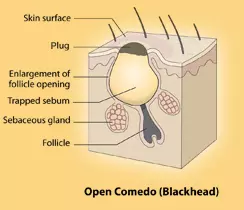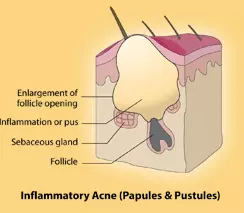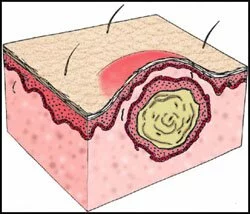Speaking about acne in everyday life we commonly use two words to name this skin condition: pimples and zits. However, everyone must have noticed that they can be different - bigger and smaller, white and black, with or without the reddening of the surrounding tissues. According to the character of zits, doctors have developed several terms to differentiate acne types. They need such classification in order to identify the severity and duration of the condition, as well as to use the most appropriate and effective treatment option in every particular case.
If a sufferer knows what type of acne he has, he can understand whether his condition requires medical treatment alongside with guidance of a healthcare professional, or it can be managed at home, using OTC medications or simple preventive measures as washing twice a day, exfoliating softly, and avoiding oily skin products.
Therefore, acne can manifest itself through the appearance of: -  comedones: a comedo is the first, early or initial stage of acne pimple, characterized by the blocking of a pore without any reddening or swelling of the oil gland and its surrounding. Comedones can be white (called whiteheads), completely plugging the sebaceous gland, so that air does not enter there, and black (blackheads) due to their partial blocking of the pores entrance. In this case some sebum, mixed with shed skin cells and bacteria, escape onto the skin surface and become black under the influence of air (mainly oxygen);
comedones: a comedo is the first, early or initial stage of acne pimple, characterized by the blocking of a pore without any reddening or swelling of the oil gland and its surrounding. Comedones can be white (called whiteheads), completely plugging the sebaceous gland, so that air does not enter there, and black (blackheads) due to their partial blocking of the pores entrance. In this case some sebum, mixed with shed skin cells and bacteria, escape onto the skin surface and become black under the influence of air (mainly oxygen);  - papules: a papule is a small round bump without head on the skin surface, which can be at first almost invisible, though it may feel like sandpaper if touched. However, most papules become soon inflamed and red; - pustules: a pustule is an inflamed dome-shaped pimple, filled with white or yellowish mixture of sebum, white blood cells, shed skin cells, and bacteria. It usually has a hair in the center, as it is formed around a sebaceous gland and a hair follicle. If properly treated, pustules leave no scars on the skin;
- papules: a papule is a small round bump without head on the skin surface, which can be at first almost invisible, though it may feel like sandpaper if touched. However, most papules become soon inflamed and red; - pustules: a pustule is an inflamed dome-shaped pimple, filled with white or yellowish mixture of sebum, white blood cells, shed skin cells, and bacteria. It usually has a hair in the center, as it is formed around a sebaceous gland and a hair follicle. If properly treated, pustules leave no scars on the skin;  - nodules: a nodule is a case of the more severe type of acne. It occupies a larger area of the skin and reaches its deeper layers. Nodules are always red, inflamed, and dome-shaped. They can be very painful and leave scars on the skin surface; - cysts: a cyst also belongs to the severe type of acne. It often occurs together with nodules. It is a severely inflamed sac-like lesion with the mixture of sebum, white blood cells, and bacteria inside. It is usually very painful, since it reaches deep skin layers. Cysts are very hard to treat and they almost always leave scars after healing. Some scholars treat cysts as severely inflamed nodules and thus suggest that the notion "cyst" should be abandoned.
- nodules: a nodule is a case of the more severe type of acne. It occupies a larger area of the skin and reaches its deeper layers. Nodules are always red, inflamed, and dome-shaped. They can be very painful and leave scars on the skin surface; - cysts: a cyst also belongs to the severe type of acne. It often occurs together with nodules. It is a severely inflamed sac-like lesion with the mixture of sebum, white blood cells, and bacteria inside. It is usually very painful, since it reaches deep skin layers. Cysts are very hard to treat and they almost always leave scars after healing. Some scholars treat cysts as severely inflamed nodules and thus suggest that the notion "cyst" should be abandoned.

 It is also worthy to mention one more term used by doctors it is a macule. This word is used to identify a healed acne lesion, which is usually flat and red for some days or weeks after a pimple disappears. Many macules contribute to the red color of the skin, where zits used to be. However, there is no need to worry about these red or pink places, as they vanish with the lapse of time.
It is also worthy to mention one more term used by doctors it is a macule. This word is used to identify a healed acne lesion, which is usually flat and red for some days or weeks after a pimple disappears. Many macules contribute to the red color of the skin, where zits used to be. However, there is no need to worry about these red or pink places, as they vanish with the lapse of time.
Acne, especially its severe cases, can be very distressful. However, those, who suffer from it, should not panic, because these days our medicine can offer a wide range of effective treatment options to get rid of the unpleasant condition and restore the health of the skin.
Ivanna
| Tip for you : Sign-in with Your OpenID and post faster, easier and with easy access to all your past posts. | |
|
Your Nick: |















